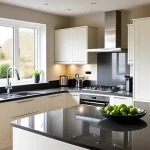Enhancing Comfort and Wellness Through Sustainable Home Choices
Sustainable home comfort UK initiatives prioritize energy-efficient heating and cooling systems that maintain consistent indoor temperatures while reducing energy consumption. These systems contribute significantly to a healthier home environment by preventing drafts and humidity fluctuations, which can affect respiratory health.
Using non-toxic, eco-friendly materials is another crucial element. Materials like low-VOC paints and formaldehyde-free insulation improve air quality by limiting harmful emissions. This directly supports better wellbeing, especially for those with allergies or sensitivities.
Also read : How Can UK Home Living Enhance Your Daily Comfort?
Natural lighting and ventilation dramatically enhance both physical and mental health. Strategically placed windows and ventilated spaces encourage airflow and sunlight penetration, which elevates mood and supports circadian rhythms. Incorporating these features within sustainable home comfort UK practices ensures that homes feel more inviting, reduce reliance on artificial lighting, and promote overall wellness.
In essence, combining these approaches—energy efficiency, eco-friendly materials, and natural elements—creates an environment that is not only comfortable but also supports long-lasting health benefits. This makes sustainable home comfort UK efforts vital for modern living focused on both comfort and wellness.
Also to discover : What are the best lighting solutions for a cozy UK living room?
Financial Advantages of Sustainable Home Improvements in the UK
Saving money while boosting property value
Energy-efficient appliances and insulation play a crucial role in energy savings UK homes experience. By reducing the need for excessive heating or cooling, these upgrades lower utility bills significantly. For example, installing a modern, well-insulated boiler or double-glazed windows can cut heating costs by up to 30%, translating into substantial yearly savings.
The UK government supports such efforts through various UK home improvement incentives, including grants and subsidies. These schemes encourage homeowners to adopt greener technologies, making sustainable upgrades more accessible. For instance, the Green Homes Grant offered vouchers to partly fund insulation or renewable energy installations, reducing the upfront cost barrier.
In the long term, introducing sustainable features also increases property value. Buyers are increasingly aware of the cost benefits sustainable appliances and eco-friendly upgrades bring, which makes homes with these improvements more attractive. Properties with energy-efficient certificates tend to sell faster and at higher prices, demonstrating that sustainable investments benefit both wallets and market competitiveness.
Practical Energy-Efficient Upgrades for UK Homes
Practical energy-efficient upgrades are vital for enhancing sustainable home comfort UK and reducing energy consumption. When selecting energy-efficient appliances UK households must consider performance ratings and compatibility with their home’s size and heating needs. For example, choosing A+++ rated boilers or refrigerators ensures minimal power usage without sacrificing functionality.
Integrating sustainable home technology elevates efficiency further. Smart thermostats and programmable heating systems adapt to daily routines, lowering energy waste by heating rooms only when needed. Such technology empowers homeowners to monitor and adjust consumption in real-time, optimizing comfort and savings.
Adopting low-energy solutions like LED lighting and solar panels profoundly impacts sustainability. LED bulbs consume up to 80% less energy than traditional lights while lasting longer, reducing replacement frequency and waste. Solar panels harness renewable energy to power household needs, cutting reliance on fossil fuels and shrinking carbon footprints.
Incorporating these upgrades not only supports energy savings UK homes but also aligns with broader eco-friendly living benefits. They provide practical, effective methods for reducing energy bills and environmental impact, making a tangible difference for households seeking greener, more affordable living.
Enhancing Comfort and Wellness Through Sustainable Home Choices
Sustainable home comfort UK strategies rely heavily on energy-efficient heating and cooling systems to maintain steady indoor temperatures with minimal energy use. These systems help prevent uncomfortable drafts and regulate humidity, creating a healthier home environment by reducing conditions that worsen respiratory issues.
Using non-toxic, eco-friendly materials greatly improves indoor air quality. Products like low-VOC paints, formaldehyde-free insulation, and natural fiber furnishings release fewer harmful chemicals, promoting better wellbeing—especially for allergy sufferers or those sensitive to pollutants.
Incorporating natural lighting and ventilation boosts both physical and mental health. Properly placed windows and vents enhance airflow, reduce dampness, and increase daylight exposure. This supports circadian rhythms, improves mood, and lowers dependence on artificial light sources.
Together, these elements form the foundation of sustainable home comfort UK initiatives by combining eco-friendly living benefits with wellness-focused design. This holistic approach creates spaces that feel comfortable, promote health, and reduce environmental impact, making sustainable choices essential for long-term home wellbeing.
Enhancing Comfort and Wellness Through Sustainable Home Choices
Creating a healthy home environment starts with incorporating sustainable home comfort UK strategies that focus on energy-efficient heating and cooling. These systems maintain stable indoor temperatures, reducing drafts and humidity swings that can trigger respiratory issues or discomfort. By using less energy, they also lower environmental impact, aligning with broader eco-friendly living benefits.
Non-toxic, eco-friendly materials play a significant role in enhancing indoor air quality. Choosing products with low or zero volatile organic compounds (VOCs), such as paints and insulation, minimizes exposure to harmful chemicals. This is especially beneficial for individuals with allergies or sensitivities, promoting a safer, cleaner living space that supports wellbeing.
Natural lighting and ventilation also contribute to wellness by improving mood and regulating the body’s internal clock. Proper airflow reduces dampness and helps prevent mold growth, a common health hazard. Sunlight exposure in living spaces increases vitamin D absorption and mental alertness, rounding out the suite of sustainable home comfort UK features that create environments fostering both physical and psychological health. Together, these elements demonstrate how eco-friendly living benefits can directly enhance day-to-day comfort and long-term wellness.
Enhancing Comfort and Wellness Through Sustainable Home Choices
Creating a healthy home environment relies heavily on sustainable home comfort UK practices that integrate energy-efficient heating and cooling systems. These systems maintain consistent indoor temperatures, significantly reducing uncomfortable drafts and excessive humidity fluctuations. As a result, occupants experience improved thermal comfort without increased energy use, which aligns with broader eco-friendly living benefits.
Selecting non-toxic, eco-friendly materials further enhances the indoor atmosphere. Low-VOC paints, natural insulation materials, and furniture made from sustainable sources release fewer harmful chemicals, improving air quality and supporting respiratory health. This aspect of sustainable design is especially crucial for those prone to allergies or chemical sensitivities.
Natural lighting and ventilation contribute to both physical and mental wellness by increasing sunlight exposure and promoting airflow. Sunlight supports circadian rhythms and vitamin D synthesis, while good ventilation controls moisture levels, reducing mold risks. Together, these features embody sustainable home comfort UK goals by fostering wellbeing and reducing environmental impact.
Enhancing Comfort and Wellness Through Sustainable Home Choices
Energy-efficient heating and cooling systems are central to sustainable home comfort UK by maintaining stable indoor temperatures while using less energy. These systems reduce uncomfortable drafts and control humidity, which helps prevent respiratory irritation and contributes to a healthier home environment. Precision in temperature regulation ensures that rooms remain comfortable without energy waste, supporting both occupant wellbeing and environmental goals.
Choosing non-toxic, eco-friendly materials further enhances air quality in the home. Products like low-VOC paints, natural insulation, and sustainable furnishings emit fewer harmful chemicals, thus improving indoor air purity. This directly benefits health by minimizing allergens and pollutants, creating a space conducive to wellness, especially for those with sensitivities.
Natural lighting and ventilation also play vital roles. Increased daylight exposure supports circadian rhythms and mental health, while proper ventilation reduces dampness and mold risk. Together, these strategies in sustainable home comfort UK work holistically to foster a healthy home environment, ensuring both physical and psychological benefits while embracing broader eco-friendly living benefits.






